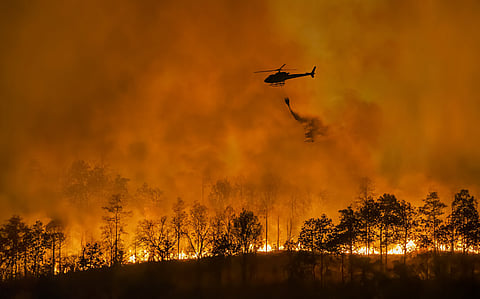

Extended fire seasons are increasingly overlapping between eastern Australia and western North America due to climate change, according to a study conducted by researchers from Australia and the Helmholtz Centre for Environmental Research (UFZ).
“Due to climate change, however, the fire seasons in both regions are getting longer. This means there is now a greater overlap of fire seasons, which could place greater pressure on the sharing of resources,” the paper, published in the journal Earth’s Future, noted.
The longer fire seasons thereby overlap each other, impacting the cross-border fire mitigating arrangements between Canada, the United States and Australia.
Future scenarios would see increasing overlapping ranging from 4 to 29 days annually by 2050, the study projected.
The researchers’ analysis showed that at present, the length of fire weather seasons overlap between the two regions by one day per year since 1979.
Canada, the US and Australia share fire-fighting resources including equipment, aircraft and at times personnel during emergencies. This coordinated resource management is possible as fire seasons in Australia and North America occur at opposite times of the year.
But the long fire season in recent decades is putting pressure on sharing of resources and jeopardising the arrangement.
For instance, a press statement issued by the university stated, “The west coast of North America and the east coast of Australia have been repeatedly hit hard by wildfires. For example, the January 2025 wildfire disaster in Los Angeles destroyed over 10,000 buildings and claimed 29 lives, according to media reports. The east coast of Australia was hit by one of the country’s most devastating bushfires between September 2019 and March 2020: more than 12 million hectares of forest and bushland burned. Fire fighters from Canada, the US, and Australia have supported each other during these disasters and many others.”
The scientists tried to understand how the timing of the fire weather reasons in these regions is changing owing to climate change.
Their examination of data revealed about 75 per cent likelihood of overlapping occurring between July and December. The number of simultaneous fire weather days in the two regions — western North America and eastern Australia — have been overlapping by one day since more than 40 years.
“This is because the fire season in eastern Australia is starting earlier in spring and overlapping with the end of the fire season on the west coast of North America,” explained Andreia Ribeiro, UFZ climate scientist and lead author of the study.
The scientists explained that the overlap depends on variability of the El Nino Southern Oscillation, a weather system that influences circulation of the ocean and atmosphere in equatorial pacific.
The fire weather is largely linked to these conditions when the sea surface temperatures get unusually high, leading to drought and heat waves.
On the contrary, the fire conditions in western North America are typically due to La Nina conditions, the opposite weather pattern to El Nino.
Thus, the fire seasons occurred at distinctly different times of the year: on the west coast of North America between June and October and in eastern Australia between October and March, the statement said.
But despite contrasting patterns, during strong fire weather overlap, the El Nino conditions were highly pronounced in the Central Pacific, only to be overshadowed by climate change said, Ribeiro.
“Climate change is causing global temperature rises and increasing drought in some regions while the El Nino effect is expected to remain largely unchanged,” said Jakob Zscheischler, UFZ climate scientist and co-author.
The narrowing window between these fire seasons is now making it challenging for coordinated international cooperation to respond to wildfires.
The researchers have now called for the countries to reduce dependency on each other and strengthen domestic fire fighting capacities.